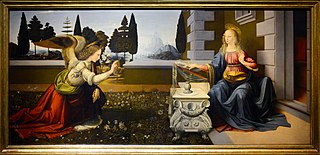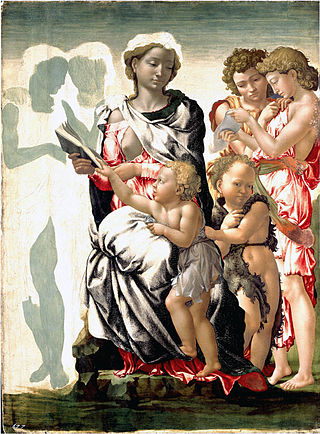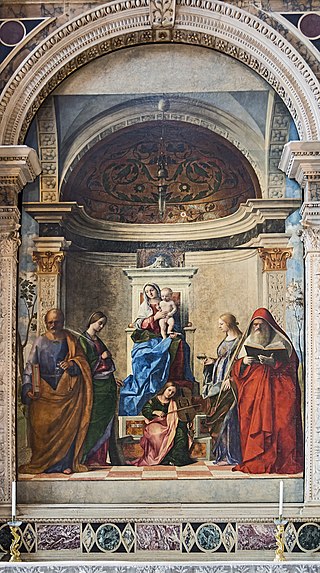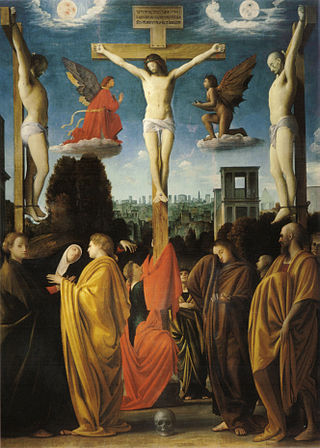
Albrecht Altdorfer was a German painter, engraver and architect of the Renaissance working in Regensburg, Bavaria. Along with Lucas Cranach the Elder and Wolf Huber he is regarded to be the main representative of the Danube School, setting biblical and historical subjects against landscape backgrounds of expressive colours. He is remarkable as one of the first artists to take an interest in landscape as an independent subject. As an artist also making small intricate engravings he is seen to belong to the Nuremberg Little Masters.

The Danube school or Donau school was a circle of painters of the first third of the 16th century in Bavaria and Austria. Many were also innovative printmakers, usually in etching. They were among the first painters to regularly use pure landscape painting, and their figures, influenced by Matthias Grünewald, are often highly expressive, if not expressionist. They show little Italian influence and represent a decisive break with the high finish of Northern Renaissance painting, using a more painterly style that was in many ways ahead of its time.

The Virgin of the Rocks, sometimes the Madonna of the Rocks, is the name of two paintings by the Italian Renaissance artist Leonardo da Vinci, of the same subject, with a composition which is identical except for several significant details. The version generally considered the prime version, the earlier of the two, is unrestored and hangs in the Louvre in Paris. The other, which was restored between 2008 and 2010, hangs in the National Gallery, London. The works are often known as the Louvre Virgin of the Rocks and London Virgin of the Rocks respectively. The paintings are both nearly 2 metres high and are painted in oils. Both were originally painted on wooden panels, but the Louvre version has been transferred to canvas.

The Alte Pinakothek is an art museum located in the Kunstareal area in Munich, Germany. It is one of the oldest galleries in the world and houses a significant collection of Old Master paintings. The name Alte (Old) Pinakothek refers to the time period covered by the collection—from the fourteenth to the eighteenth century. The Neue Pinakothek, re-built in 1981, covers nineteenth-century art, and Pinakothek der Moderne, opened in 2002, exhibits modern art. All three galleries are part of the Bavarian State Painting Collections, an organization of the Free state of Bavaria.

The Annunciation is a painting by the Italian Renaissance artist Leonardo da Vinci, dated to c. 1472–1476. Leonardo's earliest extant major work, it was completed in Florence while he was an apprentice in the studio of Andrea del Verrocchio. The painting was made using oil and tempera on a large poplar panel and depicts the Annunciation, a popular biblical subject in 15th-century Florence. Since 1867 it has been housed in the Uffizi in Florence, the city where it was created. Though the work has been criticized for inaccuracies in its composition, it is among the best-known portrayals of the Annunciation in Christian art.

The German Renaissance, part of the Northern Renaissance, was a cultural and artistic movement that spread among German thinkers in the 15th and 16th centuries, which developed from the Italian Renaissance. Many areas of the arts and sciences were influenced, notably by the spread of Renaissance humanism to the various German states and principalities. There were many advances made in the fields of architecture, the arts, and the sciences. Germany produced two developments that were to dominate the 16th century all over Europe: printing and the Protestant Reformation.

Henry Strachey (1863–1940) was an English painter, art critic and writer.

The Crucifixion is the subject of three different paintings by the Italian Renaissance master Antonello da Messina; the first one was completed around 1454/1455, the second and the third in 1475. They are housed in the Brukenthal National Museum ; the Royal Museum of Fine Arts Antwerp and in the National Gallery, respectively.

The Disputation of the Sacrament, or Disputa, is a painting by the Italian Renaissance artist Raphael. It was painted between 1509 and 1510 as the first part of Raphael's commission to decorate with frescoes the rooms that are now known as the Stanze di Raffaello, in the Apostolic Palace in the Vatican. At the time, this room was known as the Stanza della Segnatura, and was the private papal library where the supreme papal tribunal met.

The Madonna and Child with St John and Angels (c. 1497), also known as The Manchester Madonna, is an unfinished painting in the National Gallery, London, attributed to Michelangelo. It is one of three surviving panel paintings attributed to the artist and has been dated to his first period in Rome. The work first came to public attention in the Art Treasures Exhibition in Manchester in 1857, hence the title the "Manchester Madonna". Attribution of the painting to Michelangelo was in doubt for much of the nineteenth and twentieth centuries, but now most scholars are in agreement.

The Battle of Alexander at Issus is a 1529 oil painting by the German artist Albrecht Altdorfer, a pioneer of landscape art and a founding member of the Danube school. The painting portrays the 333 BC Battle of Issus, in which Alexander the Great secured a decisive victory over Darius III of Persia and gained crucial leverage in his campaign against the Persian Empire. The painting is widely regarded as Altdorfer's masterpiece, and is one of the most famous examples of the type of Renaissance landscape painting known as the world landscape, which here reaches an unprecedented grandeur.

The Barbadori Altarpiece is a painting by Filippo Lippi, dated to 1438 and housed in the Louvre Museum of Paris. It is a sacra conversazione that contains flow between each figure to depict a coronation.

The San Zaccaria Altarpiece is a painting by the Italian Renaissance painter Giovanni Bellini, executed in 1505 and located in the church of San Zaccaria, Venice.

The Martinengo Altarpiece is a painting by the Italian High Renaissance painter Lorenzo Lotto, finished in 1516. It is housed in the church of Santi Bartolomeo e Stefano in Bergamo in northern Italy.
John Fuller Russell (1813–1884), was a priest in the Church of England, a writer, mostly on theological subjects, especially religious ritual, and a notable art collector. He was a member of the committee of the Ecclesiological Society and had close connections to the High Church Oxford Movement.

The world landscape, a translation of the German Weltlandschaft, is a type of composition in Western painting showing an imaginary panoramic landscape seen from an elevated viewpoint that includes mountains and lowlands, water, and buildings. The subject of each painting is usually a Biblical or historical narrative, but the figures comprising this narrative element are dwarfed by their surroundings.

The Rest on the Flight into Egypt is a subject in Christian art showing Mary, Joseph, and the infant Jesus resting during their flight into Egypt. The Holy Family is normally shown in a landscape.

Crucifixion is an oil painting on panel of c. 1510–1512 by the Italian Renaissance painter Bramantino in the Pinacoteca di Brera, Milan. It was first recorded in that gallery's collections in 1806, without any earlier provenance.

Christ Taking Leave of His Mother is a tempera on panel painting by German artist Albrecht Altdorfer. It was executed c. 1520 and is held at the National Gallery in London.

The Holy Family is an oil painting created by Greek painter Panagiotis Doxaras. He was a prominent member of the Heptanese School. He was also an author. His son Nikolaos Doxaras was also a famous painter. Panayiotis was from a small village named Koutifari, close to Kalamata. He moved to Zakynthos at a young age. He studied painting with famous painter Leos Moskos. He traveled all over the Venetian empire with the famous artist including Venice. He studied painting in Venice for five years. He became a theoretical painter. He wrote several books on painting. He traveled all over the Ionian Islands. He lived in Lefkada, Zakynthos, and Corfu. He frescoed the ceiling of Panagia Faniromeni in Zakynthos. Eighteen of his paintings survived.



















